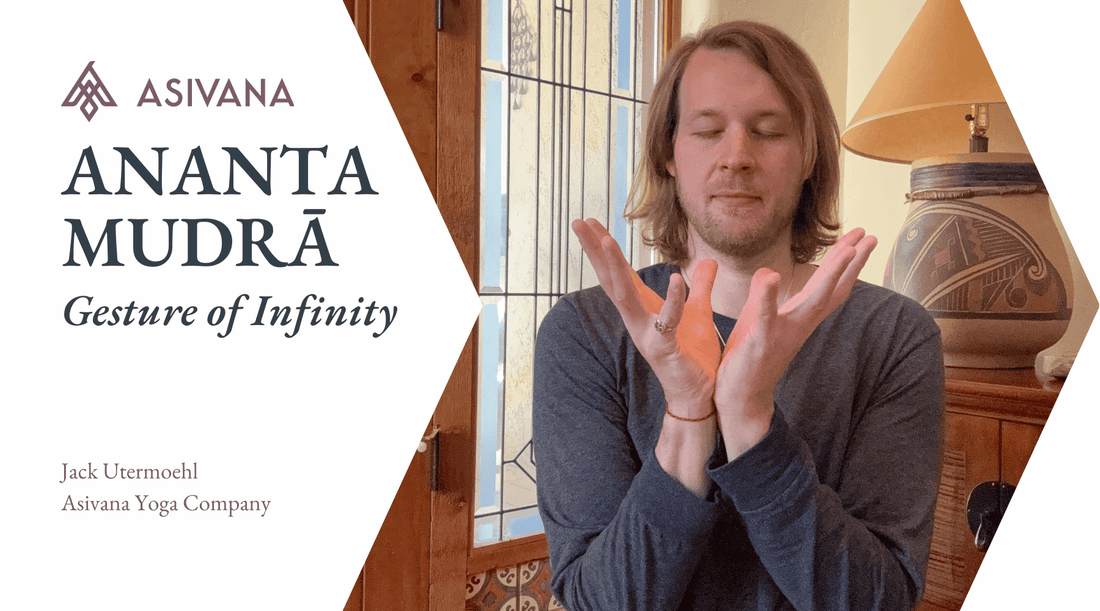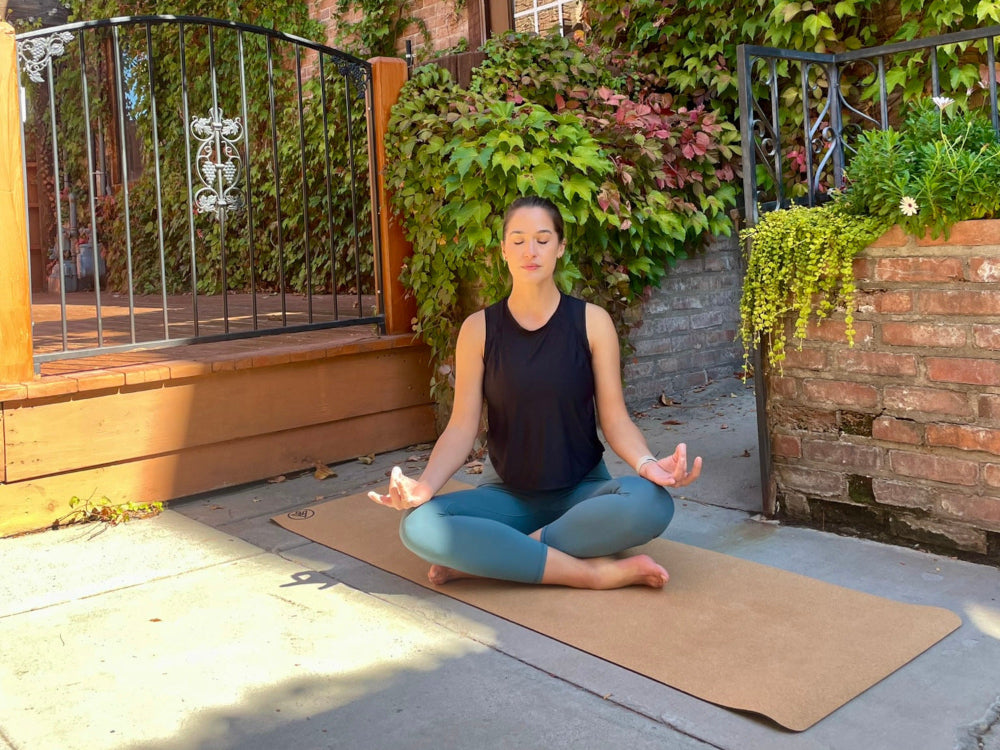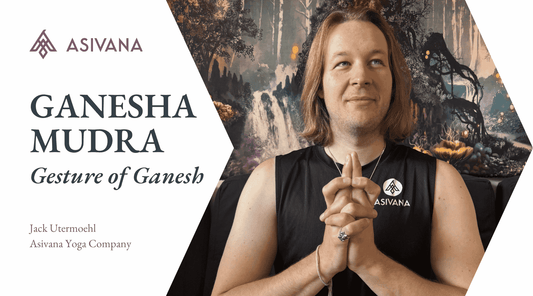
Ananta Mudra - Gesture of Infinity
Jack UtermoehlShare
Ananta Mudra (Gesture of Infinity)
Sanskrit Name: Ananta Mudrā - अनन्त मुद्रा
English Translation: Gesture of Infinity
Phonetic Spelling: Ah-NAHN-tah Moo-Drah
Ananta mudra, which translates from Sanskrit as "infinity gesture," symbolizes the endless and eternal nature of the universe. Ananta (infinity) also refers to the serpent Adishesha, the cosmic snake upon which Lord Vishnu rests.
This mudra is deeply connected to the idea of boundless space and time, helping practitioners access a deeper understanding of their place within the vast, unending cycles of life.
In yoga and meditation, ananta mudra encourages a sense of peace and patience, reminding the practitioner of the infinite potential that lies within and around them. It is especially beneficial for calming the mind and connecting to a higher state of awareness.
Ananta mudra represents an opening to the flow of energy that is limitless, fostering a feeling of liberation from constraints and boundaries.

Instructions to Perform Ananta Mudra
Find a quiet, comfortable place to sit, free from distractions. Relax your shoulders and sit with a tall spine.
Hand Position: Bring your hands together into Anjali mudra, keeping your thumb and little fingers touching, open your hands into Padma mudra. Continue spreading your fingers out allowing thumb and little fingers to separate like a lotus unfolding.
Posture: Sit in Sukhasana (easy pose) or Padmasana (lotus pose) for a grounded experience, or use a chair with both feet flat on the ground if preferred.
Breathing Technique: Inhale deeply through the nose, expanding the belly, and exhale slowly through the nose, focusing on the breath flowing effortlessly. As you breathe, allow your awareness to expand beyond your body and connect with the infinite space around you.
Duration: Practice ananta mudra for 5-15 minutes during meditation or pranayama, concentrating on feelings of openness and infinite potential.
Benefits of Ananta Mudra
Ananta mudra helps facilitate feelings of peace, calm, and connection to the universe. It encourages mental clarity and a broader sense of perspective.
Physical Benefits: Helps improve breathing capacity and balances the flow of energy within the body. Relaxes the nervous system and supports deep relaxation.
Mental Benefits: Enhances focus and mental clarity by reminding the practitioner of the infinite nature of life, allowing them to release trivial concerns.
Emotional Benefits: Encourages emotional resilience and equanimity, helping to dissolve fear and anxiety by connecting with a sense of boundlessness.
Spiritual Benefits: Cultivates a sense of unity with the infinite and eternal aspects of the universe, facilitating deeper meditation and spiritual awareness.
Symbolism and Meaning of Ananta Mudra
Ananta (infinity) refers to the infinite and eternal nature of the universe. In yogic philosophy, the serpent Adishesha represents the endless cycles of creation and destruction, symbolizing the ever-expanding nature of consciousness. By practicing ananta mudra, the practitioner taps into this energy of infinity.
This mudra reminds the practitioner of their interconnectedness with the cosmos and encourages them to release limitations and connect with the endless possibilities available in life. It symbolizes freedom from the constraints of time, space, and ego, promoting a state of liberation.
Capture your insights and deepen your connection with our Yoga Journal.Elevate Your Mudra Practice
When to Practice Ananta Mudra
Ananta mudra can be practiced during meditation, pranayama, or when practicing the infinity breath to cultivate a sense of calm and expansiveness. It is particularly beneficial when experiencing feelings of limitation, doubt, or constriction, and when seeking to connect with a higher state of consciousness.
Practice this mudra when you need a reminder of your infinite potential and the vastness of the universe. It can also be used during times of stress or emotional imbalance to evoke a sense of peace and spaciousness.
A duration of 5-15 minutes is recommended to allow the expansive effects of the mudra to take hold. Shorter periods of 2-5 minutes can still provide a calming influence.
Contraindications for Ananta Mudra
Ananta mudra is safe for most practitioners. There are no significant contraindications, but those with severe hand or finger issues may need to modify the gesture by adjusting the finger placement.
Additional Insights on Ananta Mudra
Affirmations: "I am connected to the infinite energy of the universe." / "I release all limitations and embrace boundless possibilities."
Visualization: As you hold ananta mudra, visualize yourself floating in the vast, infinite space of the universe, free from all boundaries and limitations. Allow this image to expand your mind and cultivate a sense of openness.
Associated Chakras: Ananta mudra primarily activates the Sahasrara (crown chakra), which governs spiritual awareness and the connection to the universe. Sahasrara means "thousand petal lotus".
Paired Asanas: Works well with seated postures like Sukhasana (easy pose) or Padmasana (lotus pose) to create a sense of stability and grounding while accessing the feeling of infinite expansion.
Related Pranayama: Pair ananta mudra with ujjayi breath (victorious breath) to evoke a sense of deep calm and expansion.
Meditation Techniques: Ananta mudra is ideal for use in guided meditations that focus on the infinite nature of the universe, or in mindfulness meditation to help the practitioner remain present while connecting to a broader sense of awareness.
Variations and Modifications
Alternative Hand Positions: Anjali Mudra, Padma Mudra
Adaptations for Beginners: Beginners can start by holding the mudra for 2-5 minutes, gradually increasing the time as they become more comfortable. If necessary, rest the elbows on a cushion or yoga block for support.
—— 🕉 ——

Personal Insights
What an amazing mudra this is. Ananta mudra is a great addition to the infinity breath meditation, a meditation practice that I use on a regularly basis to center and create space within myself.
Ananta mudra is difficult to hold for extended periods of time. One method of meditation I have found to be a beautiful practice is to begin meditating with anjali mudra, unfolding into padma mudra when I begin to feel energy rising, and when I feel connected I open into ananta mudra.
Give it a try!
Let us know your experience in the comments section.











